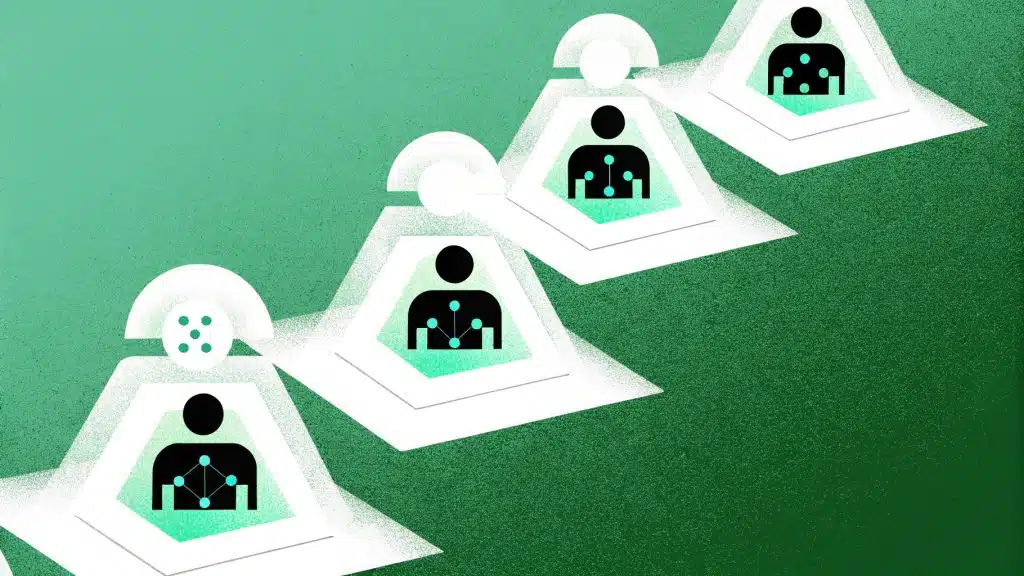For years, automation meant rigid, rule-based workflows that could only handle simple tasks. But with AI stepping in, that’s changed completely.
Now, systems can adapt to behavior, learn from patterns, and make decisions without human input at every step.
You’ll see this in how retailers manage inventory, how marketers personalize campaigns, and even how finance teams match payments with invoices.
In this post, I’ll share 15 AI automation examples that show how real businesses in 2025 are applying this tech, not in theory, but in practical ways that reduce effort and boost output.
Table of contents
- How Is AI Being Used In Automation In 2025?
- 15 Examples of AI Automation
- #1: Content Automation
- #2: AI-Generated Visuals for Marketing Teams
- #3: Hyper-Personalized Recommendations Using AI
- #4: Campaign Optimization and Trend Identification
- #5: Visual Recognition in E-commerce
- #6: Lead Scoring and Sales Automation
- #7: Accelerated Deal Closures
- #8: Automate Internal Documentation and Dev Work
- #9: Intuitive Product Discovery
- #10: Image Recognition to Match Visual Inspiration
- #11: Smarter Inventory Management
- #12: Optimized Supply Chain
- #13: Voice Shopping
- #14: Detect Fraud and Build Trust
- #15: Better Customer Segmentation with AI
- Next Steps: Adopt AI Alongside Your Team On Team-GPT
- Read More
How Is AI Being Used In Automation In 2025?
AI is being used in automation to help teams reduce repetitive tasks, speed up processes, and make faster decisions across different functions, without requiring constant manual input.
If you’re wondering what this looks like in real work, here’s what I’ve seen:
- Automating Tasks Without Coding: These tools make it easier for non-technical users, such as business managers or analysts, to automate workflows and build simple apps without writing code. I’ve used them to automate reports, connect apps, and set up alerts, without needing help from a developer.
- Bringing Data Together Across Teams: In the past, data sat in silos across marketing, sales, and operations. Now, AI connects those pieces and gives you a complete view so that you can make better decisions in real time.
- Speeding Up Hiring Workflows: AI tools now screen resumes, match candidates based on skills, and even predict if someone will be a good fit. You don’t need to go through hundreds of applications manually anymore.
- Handling Customer Queries Instantly: AI chatbots, which use natural language processing (NLP) to understand and respond to messages, can handle most first-level queries. That means fewer support tickets and quicker responses, something customers now expect as default.
- Catching Financial Issues Early: Finance teams use AI to flag issues in invoices, automate payroll, and stay up-to-date with tax rules. I’ve seen tools that auto-categorize expenses and help avoid costly errors.
- Reducing Security Risks from the Start: In 2025, automation platforms will come with built-in security layers, including access control, AI-based threat detection, and automated compliance checks. That helps avoid risks without needing a separate tool for everything.
15 Examples of AI Automation
From streamlining supply chains to automating customer interactions, AI helps reduce manual work, improve accuracy, and speed up processes that once took hours or days. Below are 15 real-world examples of how businesses are putting AI automation to work across teams, workflows, and customer touchpoints.
#1: Content Automation
For content teams handling multiple projects, repetitive tasks like drafting outlines, creating SEO briefs, or formatting can consume a lot of time. With AI tools like Team-GPT, you can automate large parts of this process.
Instead of creating content from scratch each time, you can train the model on your past work, set up prompt templates, and generate structured drafts in minutes. This is especially useful if you’re publishing at scale across blogs, newsletters, or landing pages.
Brand Example – House of Growth
This SEO agency managed to double its article volume—from 80 to 160 per month—without increasing team size. They used Team-GPT to auto-generate outlines, repurpose blog content, and speed up research.
The team also built prompt templates to match their brand tone and formatting rules. This helped them save over 85 hours per month and freed up time for strategy and optimization work instead of just execution.
Read the entire case study here!
#2: AI-Generated Visuals for Marketing Teams
Visuals are essential across various content formats, including social posts, blogs, and email headers. But relying on a designer for every small request can slow things down. With AI tools like Midjourney and DALL·E, marketers can generate visuals just by typing prompts. This speeds up experimentation, especially when you’re running A/B tests or trying different formats for ads and blogs.
Brand Example – Canva
Marketing teams can use Canva to create on-brand visuals without needing advanced design skills. For example, you can prompt “minimalist banner for skincare launch” and get variations instantly. It’s helped teams publish faster and stay consistent visually, especially when scaling across platforms.
#3: Hyper-Personalized Recommendations Using AI
AI helps personalize user experiences by analyzing individual behavior and suggesting relevant content or products. This makes users stay longer, engage more, and convert better, because the content feels tailored, not generic. You can use this in email campaigns, app onboarding flows, or on-site recommendations.
Brand Example – Spotify
Spotify takes personalization to the next level. Beyond curated playlists, they’ve introduced an AI DJ that talks to users, recommends tracks, and explains why it chose them.
They’re also piloting podcast translations using AI voice cloning to keep the original speaker’s tone intact. This lets them localize content at scale and reach wider audiences with minimal manual work.
#4: Campaign Optimization and Trend Identification
Running campaigns across multiple channels means juggling a lot of data.
AI can spot patterns that aren’t obvious, like trending keywords, underperforming segments, or unusual user behavior. It helps marketers react faster, tweak messaging, and catch missed opportunities.
Brand Example – The North Face
They used Google Tag Manager and Analytics 360 to track search queries on their site. They noticed that people were searching for “midi parka,” a term not used in their product listings.
Once they added it to product titles and descriptions, conversions tripled. AI surfaced a simple insight that made a direct revenue impact.
#5: Visual Recognition in E-commerce
AI-driven image recognition can identify products in user-generated content, suggest visually similar items, and even track how people feel based on facial expressions. This helps brands personalize product discovery and improve the customer experience (CX) without relying entirely on manual tagging or surveys.
Brand Example – L’Oréal
Their “Beauty Genius” tool uses visual AI to let users try on makeup virtually and get skincare advice. Customers can upload a selfie, and the system analyzes skin type, tone, and problem areas to recommend products. This reduces guesswork for users and makes the buying experience feel more interactive and guided.
#6: Lead Scoring and Sales Automation
Sales teams spend a lot of time chasing leads that might not convert. AI sales agents can score leads based on their behavior, engagement, and fit, so teams can prioritize the ones most likely to close.
It can also suggest the best next action, whether that’s a follow-up email, a demo, or a retargeting ad.
Brand Example – U.S. Bank
They used Salesforce Einstein to implement predictive lead scoring. The AI model analyzed CRM data and customer behavior to surface high-potential leads.
This helped their team close deals 25% faster and increased conversions by 260%. It also reduced time spent on low-quality leads, making the sales cycle more efficient.
#7: Accelerated Deal Closures
In high-stakes sectors like M&A, delays in due diligence or fragmented communication can stall deals.
AI can help by standardizing outreach, speeding up research, and automating repetitive tasks, so teams can focus on strategy and negotiations.
Brand Example – Nextoria
Nextoria, an M&A advisory firm, used Team-GPT to speed up deal-making by building tailored AI workflows.
Their team automated due diligence, used AI to analyze financial statements, and created centralized prompt libraries for repeated tasks like buyer communication.
As a result, they saw a 35% reduction in deal closure time, a 20% increase in deal value, and improved their communication with hundreds of global buyers.
Read the entire case study here!
#8: Automate Internal Documentation and Dev Work
From writing SOPs to generating user documentation, creating internal content consumes a lot of productive time. AI tools, especially those with strong integration and collaboration features, can help teams quickly create, edit, and maintain internal documents without sacrificing accuracy.
Brand Example – ITpoint Systems
ITpoint Systems adopted Team-GPT to automate parts of their documentation and development workflows. They started with a pilot across customer support and internal dev teams, then expanded company-wide.
With API-level access and usage controls, they created AI-driven workflows for generating content, streamlining brainstorming, and reducing repetitive dev tasks.
This led to a 25% increase in productivity and significant time savings on document-related tasks, freeing employees to focus on higher-value work.
Read the entire case study here!
#9: Intuitive Product Discovery
Product discovery isn’t just about personalizing based on past purchases—it’s about making the browsing experience smarter and more engaging. When shoppers land on a site, they often don’t know exactly what they want.
AI can help them understand what they’re currently looking at and surfacing similar or complementary options based on deeper product attributes.
This helps increase both product visibility and conversion rates, especially in large catalogs.
Brand Example – Lily AI
Lily AI is a product discovery platform built specifically for ecommerce retailers in fashion, home, and beauty.
The platform analyzes detailed product attributes—like fabric, cut, color, or style and uses that data to match items with what shoppers are visually and contextually drawn to.
For instance, a user browsing a white crewneck t-shirt might be shown similar shirts with the same neckline and fit, even if they’re from different brands or categories.
#10: Image Recognition to Match Visual Inspiration
When shoppers don’t have the right words to describe what they’re looking for, image recognition can bridge the gap. Instead of relying on text-based search, AI tools can analyze a photo, whether it’s a saved image or one snapped in real time, and surface visually similar products.
This makes it easier for users to discover and buy items they’ve seen online, in real life, or their social feeds, even if they don’t know the brand or name.
Brand Example – Pinterest
Pinterest has integrated image recognition directly into its platform, allowing users to tap on an item within any Pin and search for visually similar products.
For instance, if someone sees a photo of a living room setup, they can tap on the cream lamp in the corner, and Pinterest will surface similar lamps available from different retailers. This turns visual inspiration into shoppable results without requiring text input.
#11: Smarter Inventory Management
AI is helping retailers move away from manual stock checks and into real-time, automated inventory management. Whether it’s raw materials or finished goods, AI-powered systems can track inventory more accurately, reducing the risk of stockouts or overstocking.
These systems often use robots combined with image recognition to scan shelves, detect anomalies, and automatically update stock levels.
Brand Example – inVia Robotics
inVia Robotics focuses on automating warehouse tasks. Their Goods-to-Person systems allow robots to pick and move items throughout the warehouse without human intervention.
These autonomous units operate around the clock, helping e-commerce businesses speed up order processing while cutting labor costs. inVia claims its system can improve productivity by up to five times, making it easier for retailers to scale without adding headcount.
#12: Optimized Supply Chain
Managing inventory across multiple locations, keeping warehouses stocked, and forecasting demand at scale can get complicated quickly. AI makes it easier to predict demand, automate stock replenishment, and identify bottlenecks in the supply chain, all in real time.
Brand Example – Amazon
Amazon uses machine learning to forecast product demand at a granular level. Its AI systems analyze sales trends, seasonal behavior, and external factors (such as weather or regional events) to determine when and where to stock products.
This ensures popular items are available where they’re needed most, reducing delivery times and keeping fulfilment efficient across its massive logistics network.
#13: Voice Shopping
Voice shopping has become a practical use of AI in retail, making the buying process more convenient, especially for everyday items. Rather than navigating through multiple screens or typing search queries, shoppers can use simple voice commands to place orders and check delivery statuses.
This is particularly useful when multitasking or when using mobile or smart home devices.
Brand Example – Amazon Echo & Alexa
Amazon introduced voice commerce through Alexa, its AI-powered voice assistant. Shoppers can reorder items they frequently purchase (“Alexa, reorder dish soap”), get product suggestions (“What’s the best-rated running shoe under $100?”), or add things to their shopping list just by speaking.
Alexa also taps into user history and preferences, so the suggestions and prompts feel relevant and timely. For Amazon, this isn’t just about convenience; it’s about keeping users inside the Amazon ecosystem and reducing barriers to purchase.
#14: Detect Fraud and Build Trust
Trust is a non-negotiable factor in online marketplaces. With large volumes of listings and transactions, it’s nearly impossible to manually catch all instances of fraud. AI helps by identifying behavioral patterns that suggest fraudulent intent, flagging them early before they impact users.
Brand Example – eBay
eBay uses AI models that flag listings with misleading product titles, fake stock images, price manipulations, or seller accounts showing sudden spikes in unusual activity.
If a new seller account starts posting hundreds of high-ticket electronics at prices too good to be true, the AI automatically lowers their search visibility and triggers verification workflows.
Similarly, on the buyer side, attempts at return fraud or abusive refund claims are tracked and escalated. This automated system helps reduce friction for honest users while keeping the platform safer.
#15: Better Customer Segmentation with AI
Well-segmented campaigns don’t just perform better—they perform dramatically better, with conversion rates up to 200% higher.
And brands that integrate AI into their ecommerce strategy are seeing the results: they’re 23x more likely to acquire new customers and 19x more likely to be more profitable than their peers. This is because AI allows you to analyze behaviors and intent at a granular level.
Brand Example – Allbirds
Allbirds uses AI-driven tools to go beyond simple buyer profiling. The system evaluates first-time purchases and predicts what a customer is likely to buy next.
For instance, a buyer who chooses a minimalist running shoe may be grouped into a performance-oriented segment, while someone choosing a more colorful pair may fall into a style-driven segment.
Next Steps: Adopt AI Alongside Your Team On Team-GPT
If the real-world AI automation examples above got you thinking about how to bring similar efficiency into your own workflows, Team-GPT is a good place to start.
It’s designed for teams that want to go beyond one-off AI experiments and actually build repeatable, collaborative systems around automation. You can:
- Use multiple AI models in one chat, including ChatGPT, Claude, and your in-house models, without switching tools.
- Share prompts, build a centralized use case library, and manage all your automation flows in one place.
- Test different outputs using forked chats and collaborate with teammates in real time.
- Generate images using DALL·E, conduct live web research, and assign personas to AI agents, all inside a single platform.
- Track usage, organize conversations, and scale content and operations without relying on scattered apps or workflows.
Book a demo to see how your team can automate better, together.
Read More
- 15 Examples & Use Cases of AI Agents in 2025: Real-world examples showing how AI agents are being used across industries.
- AI Agents For Small Businesses – Types, Use Cases & Software: A guide to understanding different types of AI agents and how small businesses can use them.
- The 10 Best AI Sales Agents In 2025 [Reviewed]: A breakdown of top AI sales agents and how they’re helping teams close more deals.
- 17 ChatGPT Prompts For Sales To Help You Win More Business: Practical prompts to support your sales conversations and workflows.
- 32 AI Prompts For Business In 2025 That Work In Any Industry: Prompts designed to support business functions, no matter the industry.
- Best 10 AI Automation Tools & Software In 2025 [Reviewed]: A list of AI tools simplifying business automation tasks in 2025.

Iliya Valchanov
Iliya teaches 1.4M students on the topics of AI, data science, and machine learning. He is a serial entrepreneur, who has co-founded Team-GPT, 3veta, and 365 Data Science. Iliya’s latest project, Team-GPT is helping companies like Maersk, EY, Charles Schwab, Johns Hopkins University, Yale University, Columbia University adopt AI in the most private and secure way.


